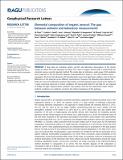Elemental composition of organic aerosol: The gap between ambient and laboratory measurements
Author(s)
Chen, Qi; Heald, Colette L.; Jimenez, Jose L.; Canagaratna, Manjula R.; Zhang, Qi; He, Ling-Yan; Huang, Xiao-Feng; Campuzano-Jost, Pedro; Palm, Brett B.; Poulain, Laurent; Kuwata, Mikinori; Martin, Scot T.; Abbatt, Jonathan P. D.; Lee, Alex K.Y.; Liggio, John; ... Show more Show less
DownloadHeald_Elemental composition.pdf (992.9Kb)
PUBLISHER_POLICY
Publisher Policy
Article is made available in accordance with the publisher's policy and may be subject to US copyright law. Please refer to the publisher's site for terms of use.
Terms of use
Metadata
Show full item recordAbstract
A large data set including surface, aircraft, and laboratory observations of the atomic oxygen-to-carbon (O:C) and hydrogen-to-carbon (H:C) ratios of organic aerosol (OA) is synthesized and corrected using a recently reported method. The whole data set indicates a wide range of OA oxidation and a trajectory in the Van Krevelen diagram, characterized by a slope of −0.6, with variation across campaigns. We show that laboratory OA including both source and aged types explains some of the key differences in OA observed across different environments. However, the laboratory data typically fall below the mean line defined by ambient observations, and little laboratory data extend to the highest O:C ratios commonly observed in remote conditions. OA having both high O:C and high H:C are required to bridge the gaps. Aqueous-phase oxidation may produce such OA, but experiments under realistic ambient conditions are needed to constrain the relative importance of this pathway.
Date issued
2015-05Department
Massachusetts Institute of Technology. Department of Civil and Environmental EngineeringJournal
Geophysical Research Letters
Publisher
American Geophysical Union (AGU)
Citation
Chen, Qi, Colette L. Heald, Jose L. Jimenez, Manjula R. Canagaratna, Qi Zhang, Ling-Yan He, Xiao-Feng Huang, et al. “Elemental Composition of Organic Aerosol: The Gap Between Ambient and Laboratory Measurements.” Geophysical Research Letters 42, no. 10 (May 22, 2015): 4182–4189. © 2015 American Geophysical Union
Version: Final published version
ISSN
00948276